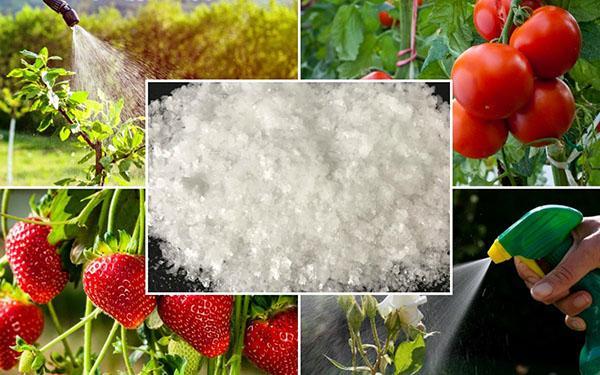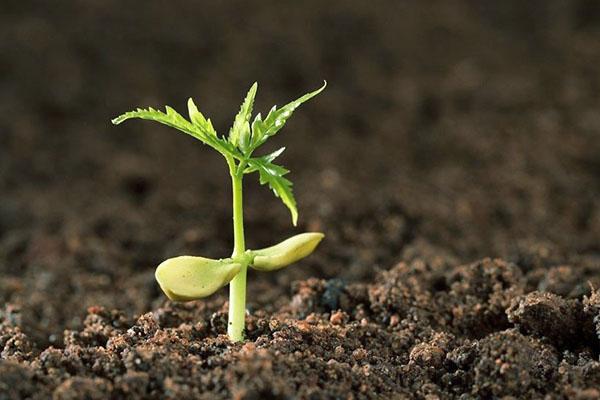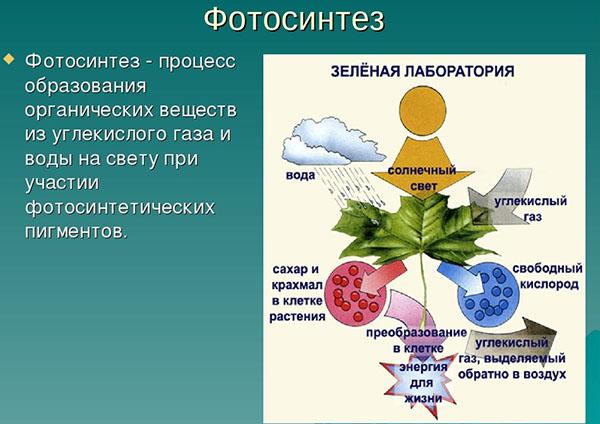Various uses of boric acid in horticulture and horticulture
 This amazing product simultaneously serves as an insecticide, fertilizer, and growth stimulant. Due to these versatile properties, the use of boric acid in horticulture and horticulture is becoming more and more popular. Florists use it as a drug that stimulates the splendor of the flowering of indoor plants. In other cases, seeds are soaked in the working solution for their rapid germination. The soil fertilized with this mineral composition becomes 2-3 times more fertile. Therefore, it is important to know how to apply this mixture correctly.
This amazing product simultaneously serves as an insecticide, fertilizer, and growth stimulant. Due to these versatile properties, the use of boric acid in horticulture and horticulture is becoming more and more popular. Florists use it as a drug that stimulates the splendor of the flowering of indoor plants. In other cases, seeds are soaked in the working solution for their rapid germination. The soil fertilized with this mineral composition becomes 2-3 times more fertile. Therefore, it is important to know how to apply this mixture correctly.
About boric acid from a school biology course

Inorganic fertilizer boric acid helps to increase the sugar content in fruits of many vegetables. As a result, they become even tastier and grow to enormous sizes.
 To provide your planting with useful elements and protect from pests, you need to make this useful additive on time. The external features of the culture will tell the gardener whether to do this.
To provide your planting with useful elements and protect from pests, you need to make this useful additive on time. The external features of the culture will tell the gardener whether to do this.
Therefore, boric acid fertilizer should be used in cases where:
- leaves turn yellow, curl and fall off;
- inflorescences are smaller or not tied at all;
- the kidneys dry up or stop developing;
- branches die off (especially at the tips);
- the fruits are deformed.
 These alarming symptoms can be observed with a deficiency of boron nutrient compounds in the soil. However, many consider the listed signs to be a consequence of a lack of moisture. As a result, gardeners begin to water the vegetation, thereby provoking the onset of bacteriosis, gray rot and other fungal diseases.
These alarming symptoms can be observed with a deficiency of boron nutrient compounds in the soil. However, many consider the listed signs to be a consequence of a lack of moisture. As a result, gardeners begin to water the vegetation, thereby provoking the onset of bacteriosis, gray rot and other fungal diseases.
Timely introduction of boric acid has a beneficial effect on the keeping quality of fruits. Then they retain their freshness and elasticity much longer, so they do not rot.
The use of boric acid in horticulture and horticulture: all the subtleties of the process

Agronomists identify several plants that especially require regular application of this fertilizer. Among them:
- apple trees;
- pears;
- swede;
- Brussels and cauliflower.

The average need for a valuable chemical element is felt by other agricultural crops:
- varieties of salads;
- many varieties of tomatoes;
- stone fruit crops;
- carrot.
 At the same time, potatoes, legumes, herbs or strawberries are fertilized with mineral composition only when necessary. Nevertheless, quite often the use of boric acid in the country depends on the acidity of the soil. Therefore, if this indicator is below 5 pH, then it is recommended to liming the site. Wetlands, chernozems or sod-podzolic types of soil also need such fertilization.
At the same time, potatoes, legumes, herbs or strawberries are fertilized with mineral composition only when necessary. Nevertheless, quite often the use of boric acid in the country depends on the acidity of the soil. Therefore, if this indicator is below 5 pH, then it is recommended to liming the site. Wetlands, chernozems or sod-podzolic types of soil also need such fertilization.
Overdose of boric acid. The first signs of this phenomenon are burns on the lower leaves.These yellow spots grow rapidly, which leads to the twisting of the plates and their further death.
For the use of boric acid in horticulture and horticulture, it is important to accurately calculate the proportions of powder flour. The dosage and consumption of the working solution largely depend on the intended purpose of the prepared suspension. It is used as a growth-promoting fertilizer or as a protective agent.
Features of professional seed treatment with boric acid
 It is worth knowing that this substance belongs to the class of poorly soluble compounds. Therefore, to prepare a nutrient solution, you need to dilute 0.2 g of the powder mixture in 1 liter of hot liquid.
It is worth knowing that this substance belongs to the class of poorly soluble compounds. Therefore, to prepare a nutrient solution, you need to dilute 0.2 g of the powder mixture in 1 liter of hot liquid.
Seeds are treated with boric acid in several ways:
- a gauze bag with grains is immersed in the emulsion for 48 hours;
- seeds of cucumbers, cabbage and zucchini are soaked for 12 hours;
- bulbs, as well as grains of carrots, tomatoes and beets are kept in solution for at least a day;
- large volumes of seed are mixed with a powdery mass, to which talc is also added.

How to determine one gram of powder? It is collected in a teaspoon, poured onto a sheet of paper and evenly distributed into 5 equal parts. One of them will be 1 year.
 It is recommended to process the beds with the prepared working fluid before planting. For each hundred square meters of the site, up to 10 liters of water suspension are introduced. At the same time, for most vegetable crops, only 1-2 liters are consumed.
It is recommended to process the beds with the prepared working fluid before planting. For each hundred square meters of the site, up to 10 liters of water suspension are introduced. At the same time, for most vegetable crops, only 1-2 liters are consumed.
In addition, many recommend adding baking soda (5 g) and potassium permanganate (1 g) to the working solution.
We save indoor flowerpots
 Violets and pelargoniums need enough calcium to form full ovaries. For this reason, many growers use boric acid for indoor plants. A solution, which is prepared according to the recipe of 0.5 g / l, is sprayed on the flowerpots at the time of laying the buds and during their flowering. Also, the powder mixture is applied to the soil during transplanting - 1 g / m².
Violets and pelargoniums need enough calcium to form full ovaries. For this reason, many growers use boric acid for indoor plants. A solution, which is prepared according to the recipe of 0.5 g / l, is sprayed on the flowerpots at the time of laying the buds and during their flowering. Also, the powder mixture is applied to the soil during transplanting - 1 g / m².
The soil is also shed with an aqueous emulsion of boric acid. 10 sq. meters consume a bucket of prepared solution. 10 g of the substance are dissolved in this amount of liquid.
Boric acid to help potatoes
 This root vegetable does not particularly need boron-containing preparations. Nevertheless, the appearance of scab on the culture and the delay in plant development indicate that it is necessary to feed. The solution is prepared according to the following scheme: 6 g of powder is added to 10 liters of liquid. This amount of the composition will be enough for watering 1 are of a vegetable garden.
This root vegetable does not particularly need boron-containing preparations. Nevertheless, the appearance of scab on the culture and the delay in plant development indicate that it is necessary to feed. The solution is prepared according to the following scheme: 6 g of powder is added to 10 liters of liquid. This amount of the composition will be enough for watering 1 are of a vegetable garden.
In addition, many spend potato processing boric acid before planting. As soon as the tubers release the first seedlings, they are sprayed with an aqueous emulsion. It is very simple to prepare it:
- take 10-15 g of the drug;
- diluted in 10 liters of warm water;
- irrigate root crops at a rate of 50 ml / kg.
Along with boron-containing dressings, phosphorus fertilizers are also used. Ordinary ash can replace such complexes. It is worth knowing that 1 kg of this substance contains 0.2-0.7 g of boron. In this regard, contribute more than usual.
"Apple trees and pears blossomed" from the introduction of boric acid
 When the tops of the trees begin to die off, and the leaves form into dense rosettes, it means that boric starvation has begun. It is also accompanied by deformation of fruits and foliage.
When the tops of the trees begin to die off, and the leaves form into dense rosettes, it means that boric starvation has begun. It is also accompanied by deformation of fruits and foliage.
In such cases, emergency treatment of trees with boric acid is necessary, which will help:
- keep the remaining ovaries;
- to develop culture immunity;
- increase productivity (up to 25-30%);
- increase the keeping quality of fruits.
 The first time the procedure is carried out when the buds bloom, and again - 5-7 days after the first. To prepare an aqueous solution, you will need 10 g of a powdery mass, with a greater exposure - 20 g, as well as 10 liters of water.
The first time the procedure is carried out when the buds bloom, and again - 5-7 days after the first. To prepare an aqueous solution, you will need 10 g of a powdery mass, with a greater exposure - 20 g, as well as 10 liters of water.
The crown of each tree is carefully sprayed. Depending on the state of the culture, the flow rate of the working fluid can be from 2 to 10 liters.
Boric acid combined with tomatoes
 The lack of useful elements in tomatoes is evidenced by a blackened, dying growth point. Fruits and leaves of plants are covered with brown spots. In addition, tomatoes begin to vigorously start to release many side shoots. To prevent this from happening, farmers recommend feeding the plantings at the time of the ejection of the peduncle, but before the formation of buds. As in all other cases of using boric acid in horticulture, the dosage of the substance remains standard - 1 g / l. In addition, they suggest processing the crop seeds for 24 hours.
The lack of useful elements in tomatoes is evidenced by a blackened, dying growth point. Fruits and leaves of plants are covered with brown spots. In addition, tomatoes begin to vigorously start to release many side shoots. To prevent this from happening, farmers recommend feeding the plantings at the time of the ejection of the peduncle, but before the formation of buds. As in all other cases of using boric acid in horticulture, the dosage of the substance remains standard - 1 g / l. In addition, they suggest processing the crop seeds for 24 hours.
Before planting seedlings, the well is watered with a solution. However, before that, it should be well moistened with plain water.
Feeding crops with a miracle solution
 An emulsion is prepared at a rate of 1 g / l. Depending on the technical characteristics of the soil and the characteristics of the plants, the dosage can be 0.5 g / l or 0.1 g / l. First, the drug is dissolved in a small amount of water, and then the missing volume is supplemented. The event is planned for the evening hours. This will help prevent leaf burns.
An emulsion is prepared at a rate of 1 g / l. Depending on the technical characteristics of the soil and the characteristics of the plants, the dosage can be 0.5 g / l or 0.1 g / l. First, the drug is dissolved in a small amount of water, and then the missing volume is supplemented. The event is planned for the evening hours. This will help prevent leaf burns.
It is recommended to be carried out 3 times for the whole season:
- the beginning of budding;
- period of violent flowering;
- the fruiting phase of crops.
In most cases, farmers recommend spraying the plants rather than watering them. Base dressing with boric acid is carried out only in emergency situations. When strawberries or potatoes are suffering from boron deficiency, then this procedure will be appropriate. The liquid is introduced so that it does not get on the green mass of the culture.
Ant death
 At the same time, the use of boric acid in horticulture and horticulture is associated with its insecticidal properties. You can get rid of ants with this white powder. You only need to boil 2 eggs. Mash their yolks and mix with ½ tsp. white mixture. Then mold several balls from the mass and spread them in places where insects accumulate. A few days and the ants will go to work.
At the same time, the use of boric acid in horticulture and horticulture is associated with its insecticidal properties. You can get rid of ants with this white powder. You only need to boil 2 eggs. Mash their yolks and mix with ½ tsp. white mixture. Then mold several balls from the mass and spread them in places where insects accumulate. A few days and the ants will go to work.
All of these examples of the use of a common chemical show how much is useful. Since the cost of an amazing product is small, it is quite appropriate to rush to purchase it.